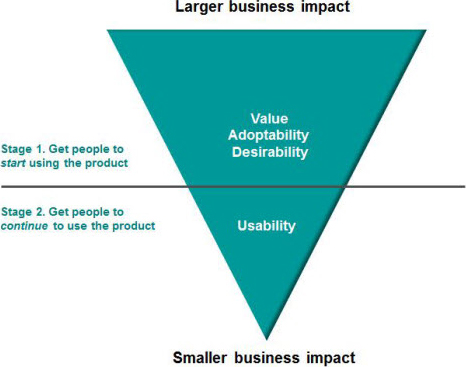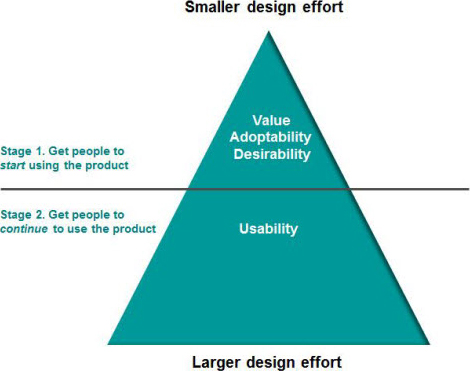Go to article
Published: August 6, 2012
“User experience is much more than just ease of use. In fact, when it comes to business impact, … usability is of less importance than the other three elements….”
In Part I of this series, I provided an overview of the four elements of user experience: usability, desirability, adoptability, and value. By decomposing user experience into these four elements, we can see that user experience is much more than just ease of use. In fact, when it comes to business impact, I would argue that usability is of less importance than the other three elements—even though it is the most frequently mentioned aspect of user experience. The reason? That’s the topic of this column.
We can break down how users interact with a product into two stages. At the first stage, a user has yet to use the product, but is considering whether to use it. If the user finds it appealing, he may start using it. Getting people to start using a product has greater business impact, but designers often expend too little effort at this stage to fully realize the potential business impact. At the second stage, the user is actually using the product, and that is when usability plays a critical role. Let’s look at a few examples to illustrate these two stages.
Stage 1—Getting prospective users to start using a product—for example:
“Getting people to start using a product has greater business impact, but designers often expend too little effort at this stage to fully realize the potential business impact.”
- persuading shoppers to start using Groupon to find good deals
- getting users to download and start using the Yahoo! Toolbar for Web browsers
- persuading home buyers to start using Zillow.com to search for a new home
- prompting runners to start using the RunKeeper mobile app to track their progress and improve their fitness
Stage 2—Getting existing users to continue using a product—for example:
- encouraging shoppers to rely heavily on Groupon for shopping
- getting users to habitually use the Yahoo! Toolbar
- encouraging home buyers to visit Zillow.com repeatedly by satisfying their needs
- providing an easy-to-use and engaging experience on RunKeeper for runners’ fitness-related tasks
To better understand the business impact and design effort for these two stages, let’s look at the diagrams shown in Figures 1 and 2, respectively.
Figure 1—Getting people to start using a product has a greater business impact

Figure 2—Expending too little effort on getting people to start using a product

Getting Users to Start Using a Product Is Key to Business Success
“Value, adoptability, and desirability have a greater impact on the first stage, while usability has a greater impact on the second stage, when users’ ability to complete their tasks successfully is a determining factor of their experience.”
In light of business impact, the first stage is more important, because a business can generate revenue only once users have started using a product. Value, adoptability, and desirability have a greater impact on the first stage, while usability has a greater impact on the second stage, when users’ ability to complete their tasks successfully is a determining factor of their experience.
If you design a product to support value, adoptability, and desirability, people will start using the product. On the other hand, if a product design excels in usability, once users start using the product, they’ll be able to perform their tasks successfully. But it’s still necessary to answer the million-dollar question: How can you get people to use the product in the first place?
Of course, value, adoptability, and desirability play a role at Stage 2 as well. They are important factors in driving the continuous usage of a product. However at Stage 2, they’re less important than at Stage 1.
Having worked extensively with product managers and designers, one thing I’ve noticed is that they typically place much more focus on Stage 2 than on Stage 1. For example, a product team might focus on how to design a product’s user interface to make it easy to use, but pay little attention to how to attract users to the product or on aligning product features and content to users’ needs. They often assume that users have somehow already decided to use the product, and the designers’ responsibility is simply to ensure a good experience while using it.
“Why is this misalignment between design effort and business value so prevalent? Part of the reason is certainly a lack of understanding of the business impact of the four user experience elements. However, a bigger reason may be a fragmented product design process.”
In comparing Figures 1 and 2, you can see that a lot of design effort gets devoted to Stage 2, even though it has less business impact than Stage 1.
Why is this misalignment between design effort and business value so prevalent? Part of the reason is certainly a lack of understanding of the business impact of the four user experience elements. However, a bigger reason may be a fragmented product design process. Often companies divide the management of product strategy and design into components that are the responsibility of different teams, as follows:
- Value is the purview of the business unit.
- Adoptability is the concern of the marketing team.
- Desirability may be the concern of either the marketing or the branding team.
In such a case, different teams work in silos on user experience elements that should be integrated with one another and, typically, do not even involve the product design team in these conversations. Thus, product designers do not influence these elements of the user experience, and their role is limited to delivering visual and interaction designs for the user interface itself.
Aligning Product Design to Business Benefits
Now that I’ve discussed the misalignment between business impact and product design effort, let’s consider how to reprioritize design effort by following a three-step process.
Step 1—Conduct user research to understand user needs and workflows.
“To come up with the best user experience solutions, you need to start by understanding user needs and workflows.”
First of all, to come up with the best user experience solutions, you need to start by understanding user needs and workflows. Let’s break this down by the user experience elements:
- value—To understand value, it is essential to explore and validate how a product concept benefits users. For example, if you were developing a mobile app to help people monitor and improve their health, you should really try to understand whether the proposal addresses an unmet need of the target users.
- adoptability—To understand adoptability, a workflow analysis of user behavior is crucial. You need to know users’ existing and expected processes. To continue the same example, do users start by visiting their doctor, then follow the exercise routine their doctor prescribes, or do they monitor their own health, then leverage online medical resources and mobile health apps to stay healthy?
- desirability—To improve desirability, you need to establish a holistic understanding of users’ emotional needs and hidden motivations. For example, when designing enterprise software, what would excite users is probably less about visual presentation and more about executing their tasks efficiently. That’s the sort of insight you can gain through user research.
It is important to keep in mind that, at this stage, you don’t need to worry about usability, which is something that you can focus on much later in the product design process. Instead, to align your design direction with business benefits, understanding the other three elements of user experience is far more important at this very early stage.
You can achieve all of these goals by conducting a single user research study—for example, a study that establishes a baseline understanding of target users or lets you explore and evaluate early-stage product concepts. Conducting a qualitative study to obtain rich contextual information—ideally some form of ethnographic research—is the best means of eliciting such user insights.
Step 2—Understand business opportunities and prioritize design resources.
“Define a product’s features and content based on insights from user research.”
Once you’ve painted a comprehensive picture of user needs and processes, it’s time to define a product’s features and content based on insights from user research. In particular, you should think of product strategies in terms of the user experience elements:
- value—Once you determine that users would find certain product features to be really useful, you can prioritize the development of those features to ensure that your product presents a strong value proposition to users.
- adoptability—By understanding user touchpoints and workflows, you can create product and marketing strategies that increase adoption.
- desirability—By understanding the emotional trigger points that underlie repeat usage, you can develop design solutions that provide the necessary emotional support and increase the product’s desirability.
Once your product strategy is in place, it forms the basis for a set of product design requirements, which guide the next step: translating requirements into a design direction.
Step 3—Translate business requirements into a design direction.
“Once you’ve defined the business requirements for a product, it’s time to devise design solutions that implement those requirements….”
Once you’ve defined the business requirements for a product, it’s time to devise design solutions that implement those requirements, planning your deployment of design resources accordingly. Again, let’s break this down by the user experience elements:
- value—To deliver value, it is important that you figure out an approach to designing content that elevates the visibility of the product’s value proposition.
- adoptability—To ensure adoptability, the key is to design the product’s workflows so users can discover, download, and install the product within their natural usage contexts. This typically requires that you collaborate with the team members who are responsible for those touchpoints.
- desirability—To ensure desirability, you should consider a number of factors when designing the product, ranging from visual presentation to content design to interaction design.
Conclusion
“Devote significant resources to designing for value, adoptability, and desirability and thereby enhance Stage 1 of user interaction with your product.”
Once you’ve prioritized your design effort by looking at a project through the lens of user needs and business impact, you’ll realize that you should devote significant resources to designing for value, adoptability, and desirability and thereby enhance Stage 1 of user interaction with your product. The end result will be better alignment between your design effort and business results.
No comments:
Post a Comment
Note: Only a member of this blog may post a comment.